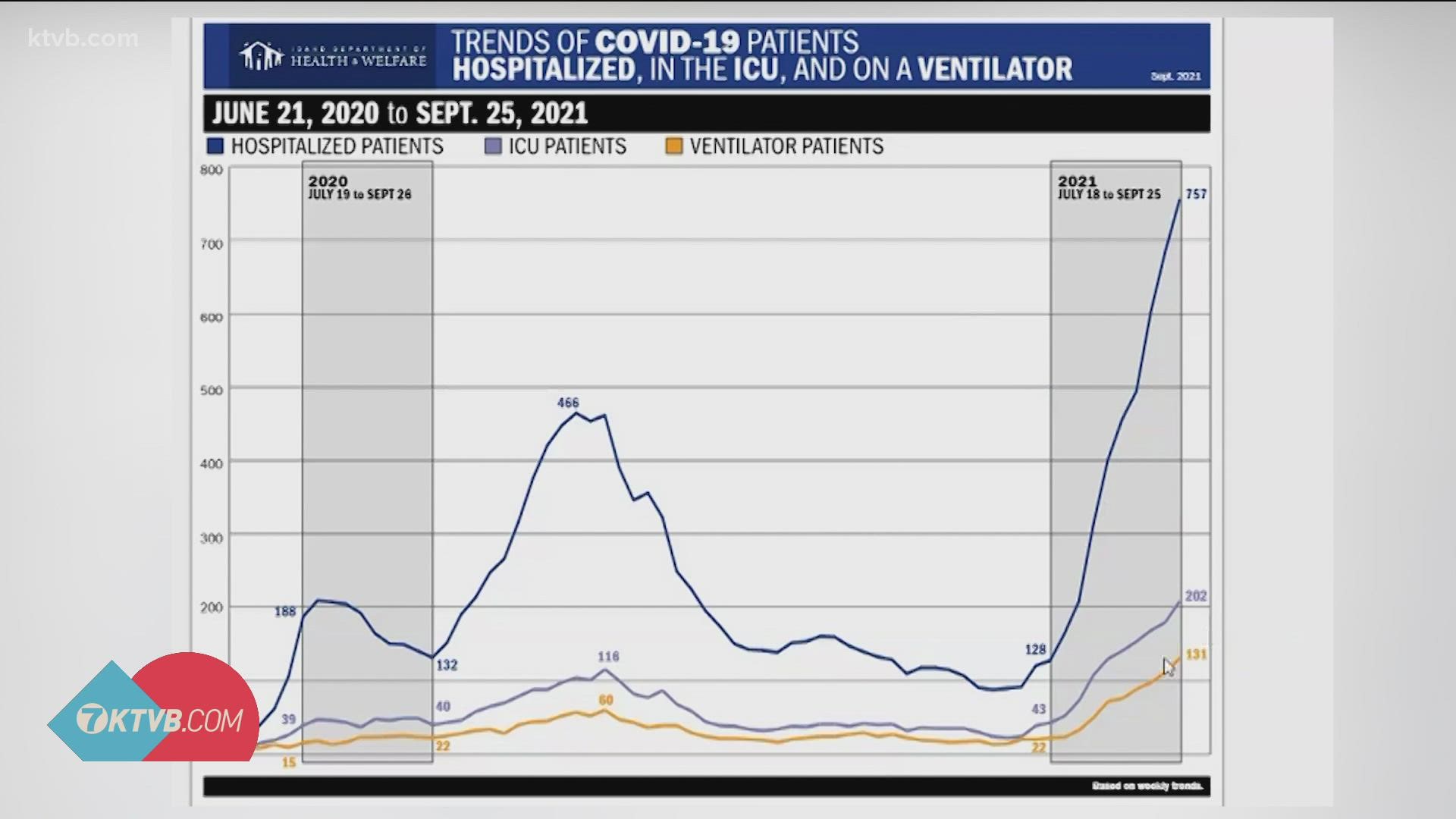BOISE, Idaho — Across the board, Idaho continues to struggle with COVID challenges. A major teller of that is new COVID data points.
“The hospitalization numbers continue to set record highs. You can see in this chart that that our number of patients in the hospital is at an average of 757 last week, that’s a record. Our ICU patients was at 202 on average, again another record. Ventilator usage was at 131, more than double the previous high,” said Idaho Health and Welfare Director Dave Jeppesen.
New data also show a concerning trend for one demographic: children.
“Weekly case counts among children are increasing more rapidly than our case counts among adults. In fact, infections among children have reached record levels in the last few weeks, and right now 20% of all new cases being reported are infections in children, which is much higher than what we were seeing this time last year,” said Dr. Kathryn Turner, Deputy State Epidemiologist.
So, where are headed and when will Idaho hit its COVID peak?
Dr. Turner says when looking COVID projections, it’s important to keep a few things in mind:
“You can’t really see how a model works until you look backwards and we always say projection is not prediction,” Turner said.
Turner explained that it can be difficult to make precise assumptions about human behavior, so projections should not be interpreted as predictions. With that said, here is the projected outlook for Idaho’s COVID peak according to the state’s model, which is a combination of multiple projections.
“What it tells us right now is we are tracking, in Idaho specifically, we are tracking at the high end of the projections, and so if it holds true, we could see in mid-November upwards of 20,000 cases a week,” Turner said.
Dr. Turner adds that hospitalizations could peak at 1,900 in a single week in late November, and deaths could peak at 305 in one week in late November. It’s important to note that the model assumes children under 12 aren't being vaccinated, but that could change if and when a vaccine is approved for them.
In terms of comparison, Dr. Turner said there are differences between the current surge and the previous peak in late 2020. For one, cases, hospitalizations, and deaths are occurring in a younger group of people compared with the winter 2020 surge.
“A higher proportion of cases are being hospitalized in the current surge compared with the previous surge. During winter 2020, about 3.5% of adults were hospitalized. In the current surge, that has increased to 5.0%,” Turner told KTVB. “We have a slightly higher proportion of hospitalized cases that require intensive care. In winter 2020, about 18% of hospitalized people were admitted to the ICU. During the current surge, that proportion has been about 22%.”
While it is wait and see, there is hope that Idaho could follow comparable states in the Southeast that are also dealing with COVID surges. Dr. Turner says assuming our experience is somewhat similar to other states, namely in the Southeast, on the downside of their recent peaks, there is hope a similar pattern could happen in Idaho.
“If we can all do the right thing and get those case counts down and we won’t see that peak in mid-November, we will flatten that curve and we may still hit a peak in November, but it would be a lower number of cases,” Turner said.
So, what could the COVID peak do to Idaho’s already strained medical system? Healthcare leaders say they continue to evaluate all options but thin resources make things complicated. Simply, the surge in COVID hospitalizations will only create longer wait times for care and create very tough care decisions for medical teams to make. Dr. Turner says there is another issue she is watching, long COVID.
“These people will have ongoing medical and therapeutic needs after their acute infection they wouldn’t otherwise have if they had not been infected. Studies are still continuing about this condition, but preliminary data from ongoing studies by researchers estimated somewhere between 5-20% of people with COVID-19 will have lingering symptoms after their acute infection has passed, with varying levels of severity. Some percentage of people with 'long covid' will continue to need hospitalization and will place an ongoing burden on the healthcare system,” Turner said.
Join 'The 208' conversation:
- Text us at (208) 321-5614
- E-mail us at the208@ktvb.com
- Join our The 208 Facebook group: https://www.facebook.com/groups/the208KTVB/
- Follow us on Twitter: @the208KTVB or tweet #the208 and #SoIdaho
- Follow us on Instagram: @the208KTVB
- Bookmark our landing page: /the-208
- And we also turn each episode into a podcast on Podbean
- Still reading this list? We're on YouTube, too:

